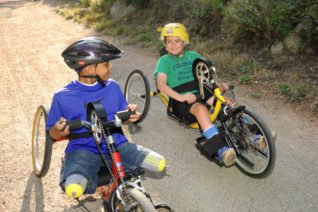Adaptive cycling or para-cycling accommodates individuals of varying abilities with modified bikes for both street and off-road riding. These include handcycles adaptive tricycles, adaptive tandem bikes, low-step bikes and wheelchair cycles – all of which are available with a number of modifications to gear and braking systems to accommodate riders. As with other adaptive sports, adaptive cycling can be done for recreation or cyclists can participate in local, regional, national, and international competitions.
Video Show a Variety of Adaptive Cycling Options (2:54)
Handcycles
Handcycles are powered using hands and arms. These bikes have a backed seat that provides support. For additional stability, lateral supports can be added to the seat. The two main styles of handcycle are recumbent and upright most of which have three wheels, but are available with four wheels. With the recumbent model, the rider is more reclined with legs extended forward. Recumbent handcycles have either a pivot steering system or a lean-to-steer system. Upright models have riders sitting like in a chair and use a pivot steering system.
How to Use a Handcycle Video (1:44)
Adaptive Tricycles
Tricycles offer increased stability and are available in recumbent and upright models. They can be modified with special seats and handlebars as well as foot plates (that replace pedals) to accommodate abilities.
Adaptive Tandem Bikes
Tandem bikes can be upright or recumbent with two, three or four wheels and seats set up for cyclists to ride inline or side-by-side.
Low-Step Bikes
With a low-step bike, the bar is at the pedal level so riders do not have to raise their leg over the saddle to get on the bike.
Wheelchair Cycles
Wheelchair cycles are attached to the front of a wheelchair. The rider pumps the handles up and down to ride.
See how to use a wheelchair cycle (1:33)
Bikes can also be modified to have a wheelchair at the front. This allows those who cannot operate a bike to enjoy experience of riding.
Additional Resources
Learn about para sports events to get an idea about what’s out there and to find some ways to participate.
If you’re interested in competitive adaptive cycling, check out Paralympics Cycling, which has information both about the Paralympic program and other ways to race and train.


Leave a Reply